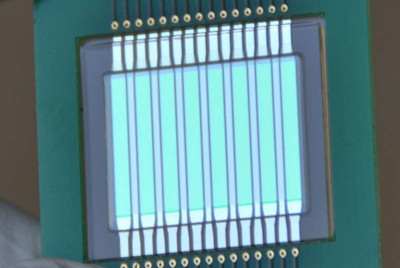
Standards of food safety and food quality have never been higher in Germany and throughout the European Union. This is especially true in the dairy industry. Yet despite such high standards, traces of impurities, pesticides and antibiotics can find their way into milk, with sometimes serious consequences for consumer health. In the EU-funded project MOLOKO, Fraunhofer researchers have teamed up with partners to develop a new optoplasmonic sensor designed to provide fast, on-site analysis of safety and quality parameters for milk. This early-warning system will bring the industry substantial savings in time and money as well as a drastic reduction in wasted product, thereby helping to improve performance along the entire supply chain.
Food safety is a critical factor in the food industry, not least in the dairy sector. Here, udder infections can lead to harmful organisms entering the milk, and chemical substances such as antibiotics or pesticides can contaminate the product via fodder or as a result of inadequate control of equipment and storage facilities. In order to prevent adulterated milk entering the food chain, checks are conducted throughout the entire production process and supply chain. Yet these standard tests are expensive and time-consuming. Samples are taken from milk tankers containing a mixture of product collected from any number of dairy farms and then analyzed in the lab. If the milk proves to be contaminated, the entire load must be destroyed, with high losses for all of the farmers and dairies concerned. If there were a test with which farmers could check their own milk before it is collected by the tanker, such wastage could be avoided.
Quality check delivers results in five minutes
In the project MOLOKO (Multiplex phOtonic sensor for pLasmonic-based Online detection of contaminants in milK), 12 partners from seven countries—including one dairy—have devised a fast and inexpensive test for identifying quality factors in milk. In a test lasting around five minutes, a new optoplasmonic sensor analyzes the product for a total of six substances, thereby providing a supplementary check and an early-warning system within the supply chain, well before the milk is pumped into the tanker. The sensor is functionalized with receptors for specific antibodies that serve as indicators of various quality and safety parameters for milk. It thereby allows dairy farms to carry out automated, on-site quantitative analyses.
Unique integrated sensor architecture
The entire system consists of a reusable microfluidic chip, organic light-emitting transistors (OLETs) or diodes (OLEDs), a sensor comprising organic photodetectors (OPDs), a nanostructured plasmonic grating and the specific antibodies. The organic photodetector is undergoing development at the Fraunhofer Institute for Organic Electronics, Electron Beam and Plasma Technology FEP, and the microfluidic chip at the Fraunhofer Institute for Electronic Nano Systems ENAS. The OLET, meanwhile, is being developed by CNR-ISMN in Bologna, and the photonic grating by the company Plasmore Srl in Pavia, both in Italy. Coordinator of the project is CNR-ISMN.
"The unique thing about our chip is that it can be reused," explains Andreas Morschhauser, researcher at Fraunhofer ENAS. "The target molecules are stripped from the immobilized antibodies by a regenerating buffer. This means that the antibodies can be reused for further tests." In fact, the estimated life of the chip is 100 test cycles. In each test, a total of six parameters relating to contaminants and proteins are measured. For this purpose, Morschhauser and his colleagues have developed a micro-fluidic system in the form of an automated, miniaturized cartridge that is replaceable. In addition to supplying information on milk safety and quality, the measured parameters also tell farmers about the health and condition of each cow. This helps them to spot infections at an early stage and begin treatment immediately. Timely treatment can lead to a more judicious administration of antibiotics and therefore to a reduction in their use.
A nanostructured grating for surface plasmon resonance
But how does the test work? Dr. Michael T?rker, a researcher at Fraunhofer FEP, explains: "Light emitted by the transistor falls onto a grating coated with antibodies specific to the various substances being tested for. When milk is flushed over the grating, any target molecules in the milk then bond with the antibodies. This alters the refractive index in the immediate vicinity of the grating, which in turn modifies how this light is reflected. The reflected light is registered by the photodetector, which measures minimal changes in the refractive index." This basic phenomenon, which occurs on specially structured nanogratings, is known as surface plasmon resonance. It provides rapid and highly sensitive readings.
The aim is to use this biosensor at various points along the value chain—both as a lab device and directly installed in dairy equipment. Moreover, it will also be suitable for testing the quality of liquids other than milk, such as beer or water. The only adjustment required is a modification to the immobilized capture molecules and to the requisite reaction buffer. This would merely involve replacing the capture molecules with ones suitably modified for the purpose in question.

